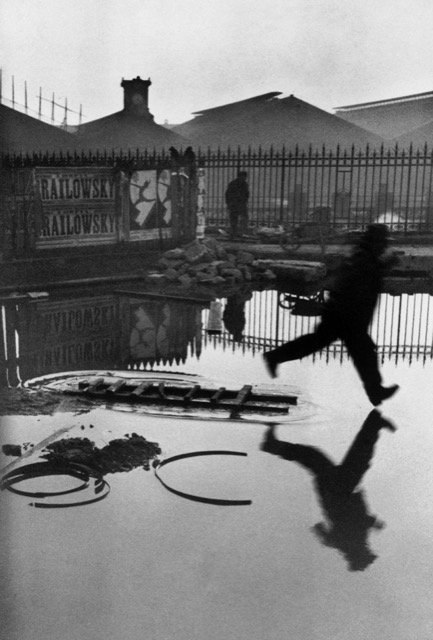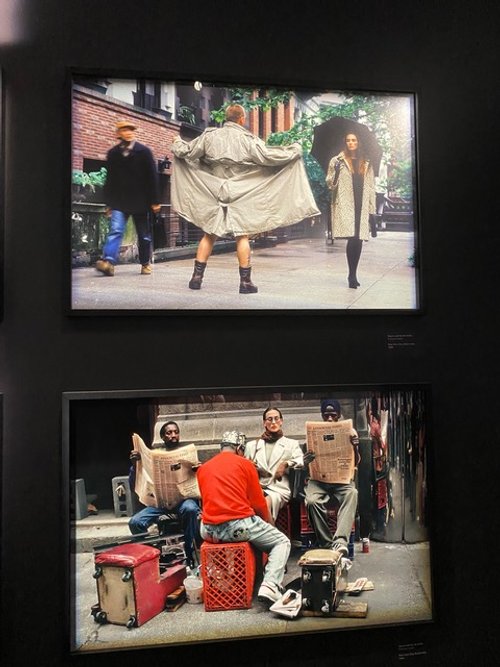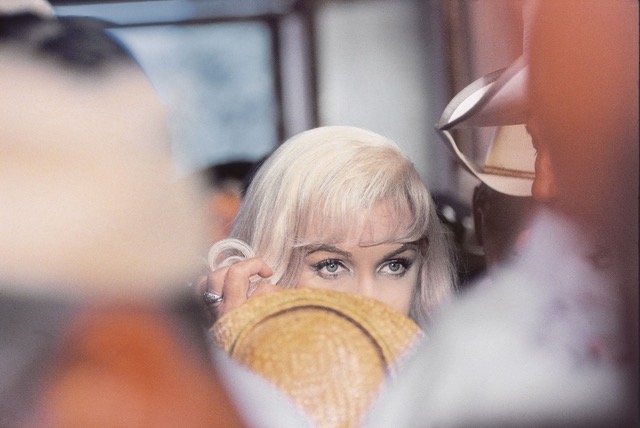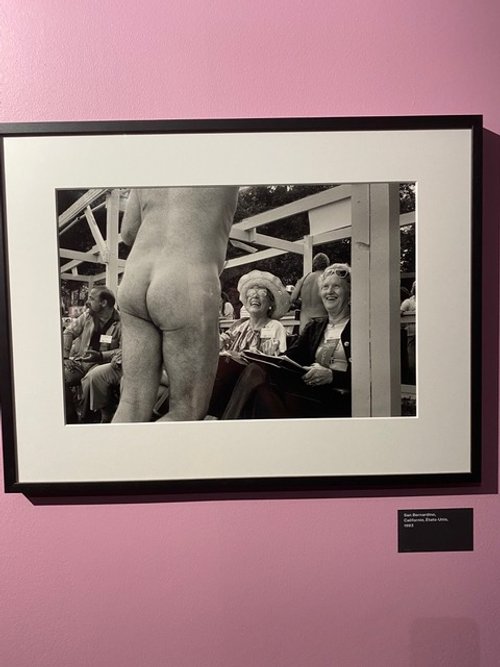The Delighted Moment
Elliott Erwitt Retrospective, Musée Maillol
“The whole point of taking pictures is that you don’t have to explain things in words”
The exhibition which has been at the Musée Maillol all summer (extended through September), is a retrospective of the photographer, Elliott Erwitt. Whose name, I must admit, was not familiar to me. The photograph advertising the exhibition also didn’t speak to me. (Figure 1) Don’t get me wrong, I like dogs. It’s just that this is a funny image, a one liner, a gag. And I wasn’t sure that I wanted to go to an exhibition potentially devoted to amusing photographs of man’s best friend.
Figure 1. Elliott Erwitt rétrospective, Musée Maillol
But now that I have been, I am very glad I went. If you are here or will be here, you should get to the exhibition before it closes. Some of Erwitt's photos I recognized immediately - they are iconic. (Figure 2) I didn’t know the photographer who took the photos, but I knew the photos. Other photos reminded me of Cartier-Bresson, a photographer whose work I admire very much. (Figs 3, 4) And yes, there were more dog photos, Erwitt has published 5 volumes of them, starting with Son of Bitch (Figs. 5, 6). Some are playful, some are poignant. In the end, they were fine, too.
Figure 2. ‘Kitchen Debate’ Nixon & Khrushchev, Moscow, 1959
Figure 3. Puddle Jumping behind the Gare St Lazare, 1932, Henri Cartier-Bresson
Figure 4. Paris, France 1989 (100th Anniversary of Tour Eiffel)
Figure 5. Birmingham, England, 1991
Figure 6. New York, 1980
The exhibition was organized by theme as per the photographer’s instructions. And also by use, or that is to say, by intent. The first floor of the exhibition is given over to black and white ‘art’ photos. Photos that Erwitt took for himself, for his art. Of people or animals or scenes that pleased or moved him in some way, the ones we have just been looking at. On another floor are color photos, Erwitt’s ’commercial’ photos. (Figs. 7, 8) Photos taken on assignment, as a job, to earn a living. His way of separating work from pleasure was simple - he always had 2 cameras. Leica for personal work (his snaps); Rolleiflex for assignments.
Figure 7. Models
Figure 8. Marilyn Monroe during filming of Misfits, 1960
And, then a happy surprise. the second floor, devoted to the museum’s permanent collection of Maillol’s drawings, paintings and sculpture, which do not usually figure in temporary exhibitions held here, was part of the exhibition. According to the gallery sheet, although their means of expression differed, “their perspectives on women, on nudity, on museums, subtly resonate with each other.” (Figs. 9, 10)
Figure 9. Dina Vierny, Maillol
Figure 10. Nude at beach
The labels next to each photo are the definition of minimalist. Place and date, that’s it. Thankfully, the wall texts are informative. And we’ll get to those in a minute. But let’s start with Elliott Erwitt’s biography. He is 95 years old and still working. His most recent book was published in 2021. Called “Found, Not Lost,” it is a compilation of photos taken a long time ago. Photos that may not have been lost, but which were found for this book. It’s an old man’s project. As one critic put it, ‘(b)y selecting these photographs he has begun to both examine and challenge how his younger self saw the world.” Five exhibitions are currently celebrating this nonagenarian, in Northern and Southern California, in Florida and Texas and Italy.
People who have written about Erwitt, mostly lament about how difficult it is to get the photographer (or his friends) to talk - either about his art or his life. That was not a problem in 2003 for John O’Mahony who wrote a profile of Erwitt for the Guardian Profile series. O’Mahony’s article is cleverly entitled, ‘Best in show’. (Did I mention that over the years Erwitt has compiled 5 volumes of dog photos?)
Elio Romano Erwitz (who was to become Elliott Erwitt) was born to Russian parents, in Paris in 1928. A decade later, he moved with them to New York (the first 10 years of his life were mostly spent in Italy). They left France the day before World War II was officially declared. They left on the last boat leaving France for New York.
In New York, Erwitt lived with his father and visited his mother on weekends. When his father left for California in 1941, Erwitt went too. It was in Hollywood that Erwitt discovered photography which became both his passion and his meal ticket. By the time he was 16, he was earning a living, so he had to learn to divide his time between taking photos of people and places that interested him and taking photos for money, like for weddings and of movie stars.
He was drafted into the army during the Korean War and lucked out when instead of going to war he went to France where he met his first wife, a Dutch woman, whose pregnancy he documented with photos of her increasingly heavy belly and then with their new born by her side. Some of those photos are here. (Figure 11)
Figure 11. Erwitt’s first wife with their baby
He has been married four times. Each of his marriages has lasted seven years. Maybe it was the proverbial ‘Seven Year Itch’ (see below) His friend Murray Sayle’s explanation is that ”Photographers are by definition interested in the surfaces of things; that is all you can photograph. And what do we call people who are only interested in the surfaces of things? Superficial! Or to put it another way, Elliott could never get past what they looked like. That kind of relationship isn't going to last very long.”
In 1954, Erwitt joined Magnum, the international photographic cooperative created in 1947 by Robert Capa, Henri Cartier-Bresson and others to protect the rights of photographers to their photos. And through Magnum, Erwitt became a set photographer on films like On the Waterfront and The Misfits.
A few of his portraits of Marilyn Monroe are here. One is his version of the photo of Marilyn’s skirt blowing up to reveal her legs as she walks over a sidewalk grate. It was the poster for The Seven Year Itch. It isn’t ‘the’ photo that we know, that one was taken by Sam Shaw. The initial shoot was at 2:00 a.m., on the street, in front of a theatre on Lexington Avenue. When the shoot was recreated in a studio, Shaw organized a press photo-call to which Erwitt showed up. Shaw took the best viewing spot for himself, but Erwitt’s vantage point wasn’t too bad. As we know, the scene is one of the most famous in cinema history. The halter top dress that Marilyn wore sold at auction in 2011 for $4.6 million.(Figure 12)
Figure 12. Photos of Marilyn Monroe for Seven Year Itch, 1955
Other film stars who Erwitt captured on the run or in formal poses include Vera Miles with Alfred Hitchcock, Simone de Beauvoir; Arnold Schwarzenegger and Andy Warhol (Figs 13, 14, 15). Political figures photographed by Erwitt include Che Guevara (Figure 16) and Fidel Castro, the grieving Jacqueline Kennedy at the funeral of her husband and the elated Obamas at Obama’s Inauguration in 2009. (Figs 17, 18)
Figure 13. Vera Miles and Alfred Hitchcock
Figure 14. Arnold Schwarzenegger
Figure 15. Andy Warhol
Figure 16. Che Guevara
Figure 17. Jacqueline Kennedy at JFK funeral
Figure 18. Obama Inauguration 2009
Did you know that Erwitt took the famous "Kitchen Debate" picture of Nixon and Khrushchev, where Nixon is poking his finger into Khrushchev’s chest. (Figure 2 above) Here’s how that happened. It was the summer of 1959, Erwitt was in Moscow to photograph an industrial fair. By coincidence, Nixon was at the same place, on the same day with Khrushchev. In front of a model kitchen, set up by Macy’s.
Here’s how Erwitt remembered it for the 2003 interview. ”It was ridiculous. Nixon was saying, 'We're richer than you are', and Khrushchev would say, 'We are catching up and we will surpass you.' …At one point Nixon was getting so irritating I thought I heard Khrushchev say in Russian 'Go fuck my grandmother'." (which Erwitt would have understood, having grown up speaking Russian with his parents). Nixon used that photo on posters for his first presidential bid. I wonder if Erwitt got royalties.
The exhibition doesn’t proceed chronologically but thematically. Most themes came about through commissions. Among them, Couples (Figure 19), Beaches (Figs 20, 21, 22) and Childhood, when Erwitt and other Magnum photographers participated in the international Baby Boomers project, taking photos of children born after the war. Erwitt’s beat was the children of the U.S.A.
Figure 19. Two Couples, Santa Cruz, 1975
Figure 20. Beach at Cannes, 1975
Figure 21. Beach, Santa Monica, 1956
Figure 22. Brighton Beach, 1956
Another category proposed by the exhibition is ‘Photography vs Abstraction’. Which Erwitt might not have approved of, having written in 2007 that, “My intention was simply to see what I saw, And to take pictures of it…” But as the gallery label notes, “photography is an art of observation, (but) it has little to do with the things we see and everything to do with the way we see them.” (Figure 23) In “Florida Keys, 1968,” for example, a long-necked, large-beaked white bird echoes the demeanor of a nearby vertical pipe and horizontal faucet. Sure, anyone could have seen those two things, but Erwitt made the juxtaposition something intriguing. (Figure 24)
Figure 23. Puerto Rico, 1969
Figure 24. Florida Keys, 1968
Cities and Street Scenes is a natural category for Erwitt who loves cities, especially his hometown, New York. One assignment must have been a dream come true - to submit photos of 150 outstanding American buildings for the 1970 Osaka World Expo. According to the gallery text, “(Erwitt) is at home wherever the street, teeming with life, offers him something to quench his passion for images.”
He seems to have fallen into taking photos of Nudes, (Figs 25, 26, 27) Dogs (Figure 28) and Museums on his own. When asked why dogs, he replied: “They are everywhere. They are usually friends. They don’t complain. And they don’t ask for a personal print.” And “I certainly look at dogs before I look at anything else. If the dog is interesting, if the dog’s situation is interesting, then I might take a picture.” (see above figs. 5, 6)
Figure 25. Couple, England
Figure 26. Newlyweds, England
Figure 27. San Bernardino, 1983
Figure 28, Nearly nudes and dogs
Of course I was especially interested in the Museums category. Erwitt’s volume of photographs of people in museums are mostly funny moments frozen in time. Like, for example, a group of people studying a label (which presumably explains why the painting supposed to be in the frame, isn’t) rather than looking at the painting next to it. (Figure 29) Another, a group of men staring at one of Goya’s Nude Majas while a lone woman gazes at the Clothed Maja next to it. (Figure 30) And yet another, taken from behind Saint-Gaudens’s bronze statue of Diana, (Figure 31) who seems to be aiming her arrow at a departing male figure. Ken Johnson, NYTimes (2011) wrote this about the photo, “(W)e behold (Diana) … (d)rawing her bow, she seems to be aiming at the silhouetted figure of a man far away down a long hallway. In this, like so many of Mr. Erwitt’s images, the light humor thinly veils poetic profundity. A modern cipher of a man is about to get his comeuppance from a mythical divinity: Diana, the virginal huntress, the sight of whom makes men fall prey to the hounds of their own lust. As the sex scandals reported almost daily in the news media attest, many powerful men have suffered, metaphorically, the fate of that unlucky voyeur Actaeon.” Johnson’s comment is prescient, could he have imagined what lay ahead for Harvey Weinstein et al.
Figure 29. At the Museum
Figure 30. Goya’s Majas, dressed (left); nude (right)
Figure 31. Metropolitan Museum of Art, New York, 1949
Little Girl in the Egyptian Wing
Self portrait with Roman remains
But I am not convinced by Johnson’s interpretation. The man isn’s oogling the Goddess, he has turned his back on Diana, he hasn’t been captivated by her charms at all. Maybe she’s just piqued that he isn’t adoring her?
The gallery text, referring to a 1995 article written by one of my favorite art historians, Carol Duncan, about the art museum as a “quasi-sacred place (where) the work of art is elevated to the rank of a cult object and visitors assume the staid and respectful demeanor of a religious procession whose stations are predetermined and whose behavior is prescribed.” Maybe, but the moments Erwitt documents are not staid or reverent… Erwitt says this about his photos of people looking at art, “(I am) a dedicated people-watcher, who likes to observe art and art watchers who observe art.”
And perhaps we shouldn’t ask anymore of his photos than that.
Erwitt’s Friends on Erwitt:
”I've always thought there was something rather Chaplinesque about Elliott…” writer Helen Ungerer.
"If you want to understand the art of Elliott Erwitt, the last person to turn to is Elliott Erwitt. Not that he can't talk, it's just that like Harpo he won't … “ writer Wilfred Sheed.
Erwitt is “a first-class pickpocket” screenwriter, Marshall Brickman,
*“His special contribution is his wit: not the Decisive moment but the delighted moment …” Adam Gopnik, Elliott Erwitt’s Paris (2023)
“Elliott has to my mind achieved a miracle, working on a chain-gang of commercial campaigns and still offering a bouquet of stolen photos with a flavor, a smile from his deeper self.” photographer, Henri Cartier-Bresson
Copyright © 2023 Beverly Held, Ph.D. All rights reserved
Dear Reader, I hope you enjoyed reading this article. Please sign up below to receive more articles plus other original content from me, Dr. B. Merci!
And, if you enjoyed reading this review, please consider writing a comment. Thank you.

































